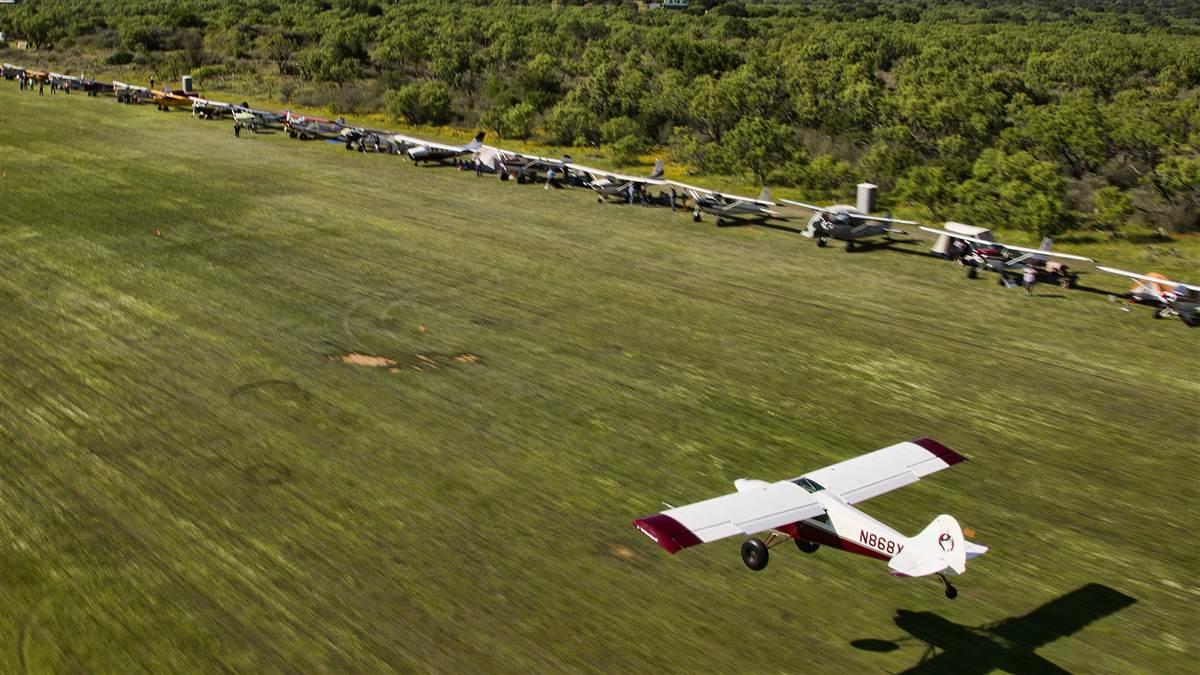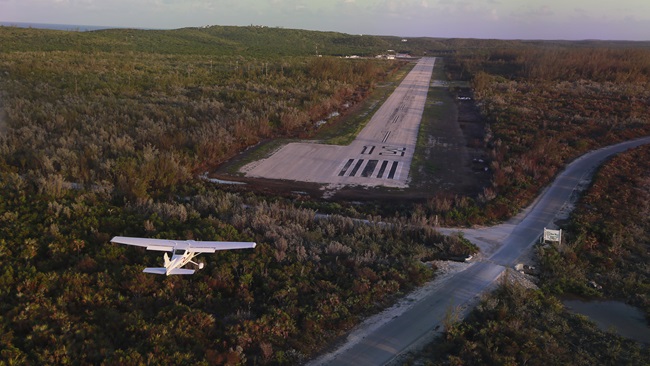Spectator sport
Texas STOL contest attracts thousands

The tailwheel struck the ground first, then the cartoonish 31-inch tundra tires. But four shock absorbers on the main landing gear and two on the tailwheel assembly protected the airframe. And an impact that would have been catastrophic in just about any other airplane was, instead, just another competition-style landing for this purpose-built monster.
The SQ–2 rolled about 80 feet into a gentle four-knot breeze, and then lurched to a stop. Total landing distance over a 25-foot obstacle: less than 300 feet.
Many of the roughly 2,500 spectators at the third annual Texas STOL Roundup stood and applauded. The contest drew about 300 airplanes and 87 competitors to the rural Llano Municipal Airport (AQO) for a spring event that has quickly become the world’s largest STOL contest. And Phil Whittemore, pilot of the SQ–2 and organizer of the event, had just showed some very bad manners by winning the Experimental Bush Class category at the contest he hosts.
It was a totally surprising outcome for Whittemore, who flew a Stearman recreationally, that he got involved in flying STOL (short takeoff and landing) at all.
“A few years ago I watched videos of the STOL competition in Valdez, Alaska, and thought that was the most amazing flying I’d ever seen,” said Whittemore, founder of an internet-based training firm. “Then I saw [the movie] Big Rocks and Long Props and became infatuated with bush flying. I figured a Valdez-style STOL competition in the Lower 48 would attract other pilots who were just as captivated by this kind of flying as I am.”

The initial event was launched by word of mouth and through backcountry flying websites, and drew 40 competitors. Adverse weather in 2015 kept the event from growing. But a sunny and mild spring weekend this year brought competitors from California to Kansas, and unique events such as the obstacle landings and new wrinkles such as a Super Heavy class—that included a Quest Kodiak and de Havilland Beaver—kept spectators’ attention.
“Pilots like this event because we’re competitive by nature, we like to have fun, and we all want to improve our skills,” Whittemore said. “Spectators like it because there’s constant action, cool airplanes, and they recognize the skill and dedication that goes into flying them. You don’t have to be a pilot to get it.”
Wiggle your toes
A no-nonsense pilot briefing on the morning of the Saturday event set a common-sense tone for the STOL competition.Jimmy Gist, a former U.S. Air Force fighter pilot, Reno racer, and native Texan, stood atop an ATV in a bright yellow Air Boss T-shirt, leather boots, and dusty cowboy hat.
“If you have an emergency, aviate, navigate, and then communicate,” he shouted to the pilots around him, some sitting on hay bales. “Fly the airplane first. Talk when you can.”
For simplicity’s sake, there would be one and only one radio frequency for all competitors, and pilots were to monitor it but remain mostly silent.
“I don’t want a bunch of talking,” Gist said. “I want lots of listening.”
Pilots were told to fly their patterns at least 500 feet agl, avoid overflying nearby homes, and keep it tight. Three airplanes would fly at a time, and ideally, takeoffs and landings would be less than one minute apart.
“Be as expeditious as you are comfortable—and don’t drag things out,” he said.
With 87 competitors making at least two takeoffs and landings each, and every one of them being measured and recorded, there was little time to waste. And there would be no tolerance for showoffs.
“There will be no steep climbs and no hot-dogging,” Gist said. Organizers had the number for the local NTSB office but very much wanted not to dial it.

Obstacle landings are a crowd favorite and test the STOL capabilites of specialized aircraft, as well as pilot skill. In this multiple exposure, a Carbon Cub, one of the most popular of today’s backcountry aircraft models, clears the cones and hits the turf.
“If you’ve got a new technique that you haven’t practiced, don’t try it for the first time here,” Gist said. “I don’t want to see anybody do anything today that they haven’t practiced many times recently.”
He ended the 15-minute briefing with an admonishment to relax, fly well, and enjoy the experience. “Take a deep breath when you get in the airplane,” Gist said. “Wiggle your fingers and toes. Think about what you’re going to do. Watch and listen. Say something if you have to. Now let’s go flying!”
Airplane wrangler
Once propellers started turning, Gist became an airplane wrangler. He’d stand at the chalk start line and wave one pilot at a time forward. He’d look forward and back to make sure the runway and final approach path were clear, and then emphatically point an index finger forward indicating the pilot was cleared for an immediate takeoff.
As soon as each contestant landed and came to a halt, a ground crew member wearing a reflective orange vest marked the exact stopping point. A laser rangefinder at the start line measured the total distance and then the stopped airplane made a hard turn to clear the runway. From the moment a landing airplane stopped until its distance was recorded and the pilot cleared the runway usually took five seconds or less. Each pilot’s shortest takeoff and landing was used to calculate the final result.
CubCrafters Carbon Cubs were the most numerous in the Light Sport category, and Piper Super Cubs and Aviat Huskys were mainstays in the Bush category. Tailwheel Cessnas, primarily 180s and 185s, filled the Heavy Touring class, as well as 182s and a 206.
And a few more exotic aircraft stirred lots of chatter. A pressurized Cessna P210 with a Robertson STOL kit had organizers wondering aloud whether it could even lumber off of the 1,700-foot grass runway, but it did so in less than half that distance. A former Italian military SIAI-Marchetti SM.1019, a stretched, turboprop version of the O–1 Bird Dog, landed in a stunningly short distance with a blast from its reversible prop; and a Quest Kodiak showed its ruggedness with a no-flare, aircraft carrier-style landing that left an impression (actually two of them) on the turf.
There’s a saying in STOL that the airplane gets credit for good takeoff performance, but landings are all about the pilot. The difference between the first- and second-place finishers frequently came down to just a few feet—and there were no points given for style or subtlety. Coarse but well-timed actions carried the day.
A new sport
While traditional airshows and fly-ins struggle to attract new audiences, the STOL Roundup is one of the few showing rapid growth. There’s a great deal of interest among pilots, backcountry aircraft manufacturers, kit builders, and young pilots. Some of the pilots in their teens and 20s are brand-new to aviation.
Industry representatives such as Craig Catto, the prop maker from California, and Tony Kasabasich, who designs and manufactures specialized shock absorbers for backcountry airplanes, also came to the event. Kasabasich, a private pilot and owner of TK 1 Racing, said the STOL organizers recognize something that other motorsports have long known: Extreme performance brings excitement, innovation, and new audiences.
“Only a small subset of pilots is ever going to fly in areas in which big tires and STOL performance is required—but that’s not really the point,” he said. “STOL contests are like rock crawls for off-road- vehicle-enthusiasts. Extreme performance and competition push the boundaries. People who come to an event like this see things being done with airplanes that they didn’t think were even possible, and that captures their imaginations.”
Also, the barriers to entry for aspiring STOL pilots and organizers are relatively low. Pilots need no special licenses or waivers, and the airplanes themselves aren’t astronomically priced. Many competitive airplanes such as Cubs, Champs, and Pacers are budget buys, and Light Sport varieties such as the Bearhawk LSA, Kitfox, Highlander, and Rans S–7 are relatively inexpensive to operate.
Organizers don’t have to apply for special-use airspace, arrange security, set crowd lines, or comply with myriad other airshow requirements.
The Llano event filled the town’s hotel rooms well in advance, but that didn’t matter to the hundreds of visitors who camped on the airport’s expansive grounds, where bluebonnets and other wildflowers provided a carpet of color. Live bands held nightly performances, and local aviation organizations and churches sold food and drinks.
The Valdez STOL contest remains the most iconic, prestigious, and best known. But video clips shared via social media and STOL demonstrations at large aviation events such as last year’s EAA AirVenture have popularized and legitimized this brand of flying far beyond its niche roots.
And those involved in it are convinced it will continue to grow and inspire.
“I don’t think it’ll be long until all of the big aviation events contain STOL elements,” Kasabasich said. “STOL is really just getting started as a sport.”
Email [email protected]



